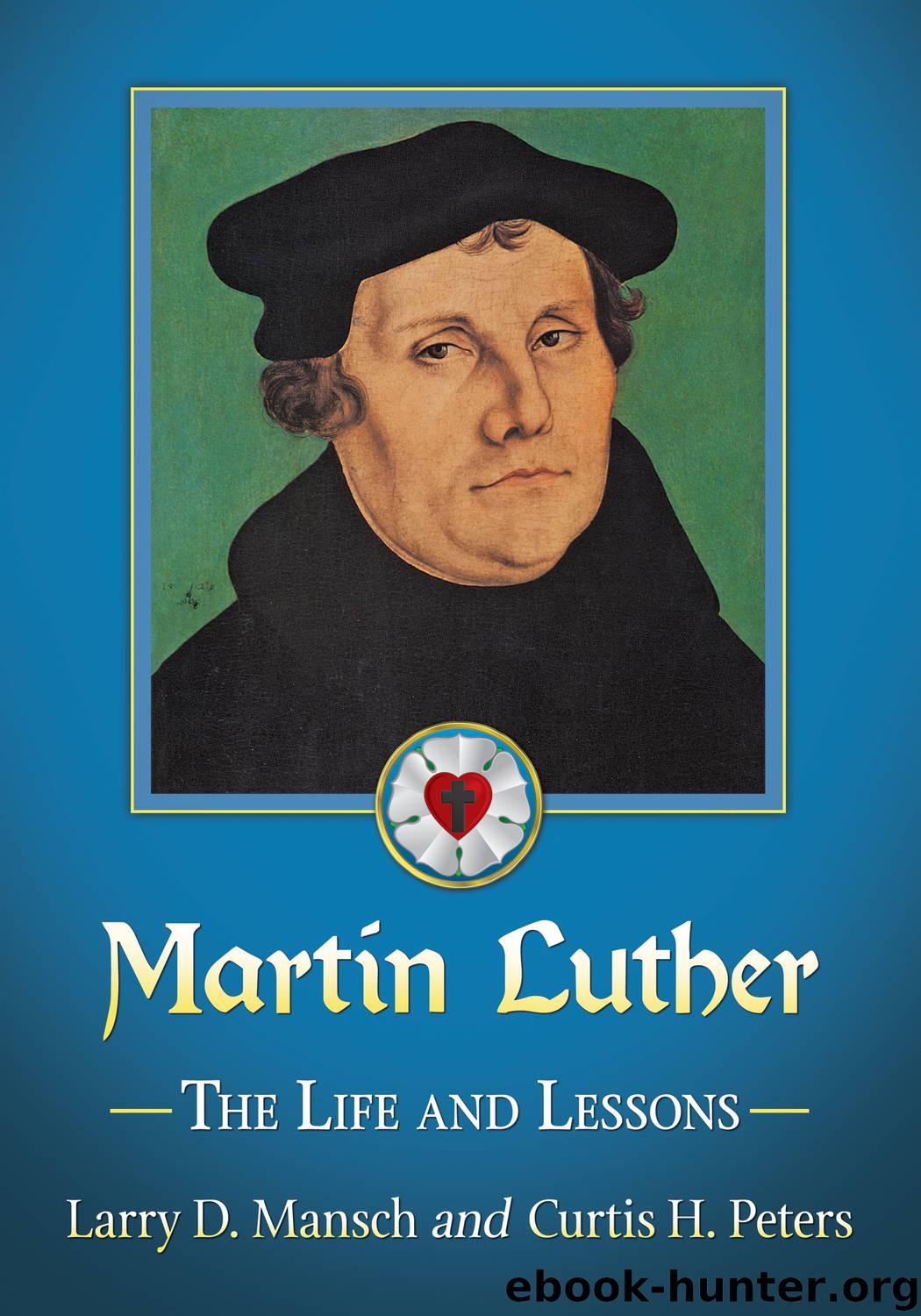Martin Luther by Mansch Larry D.; Peters Curtis H.;

Author:Mansch, Larry D.; Peters, Curtis H.;
Language: eng
Format: epub
Publisher: McFarland & Company, Incorporated Publishers
Published: 2016-06-03T04:00:00+00:00
• Chapter 17 •
The Faith Alive
Although the Peasants’ rebellion had been put down and the Catholic presence in Germany remained sizeable, by the late 1520s half of the country was Protestant. Support for the Reformation continued to grow, rapidly stretching across northern Europe and gaining footholds in England, Scotland, and even France. Now that the war was over, Luther returned to the questions still unanswered in the decade since he had posted his challenging Ninety-Five Theses on the door of Wittenberg’s Castle Church. How would these thousands of new Protestants organize themselves? What exactly would the new church look like? Now free from the domination of Rome, how were Protestants to live and worship in light of the changes that the Reformation had brought? Luther pondered his role in the emergence of the Protestant era. How could he best use his gifts of intellect and purpose and unshakable faith? Would his thunder from the pulpit, his charisma in the classroom, and his powerful and persuasive literary voice, continue to inspire his followers? Could he withstand the criticisms that had come his way for his seeming betrayal of the peasants and their cause? In short, was he still the leader of the Reformation? Luther would spend the next five years answering these questions, as he continued on his spiritual journey and sought to mold the emerging Protestant church.
Luther realized that while there had been a Reformation, there existed no actual Reformation Church in Germany. Many thousands of Protestants throughout the country were united in their faith. They had accepted Luther’s vision of a faith-based religion of truth, but there was no visible structure—no unified institution—to nurture and instruct them. “These Christians,” insisted Luther, “must be gathered into a family, and built up into a kingdom—a holy and spiritual kingdom.”1 Acting upon Luther’s request, Duke John ordered a “visitation” of all churches in Saxony. The Elector authorized teams of visitors, or commissioners, acting under the general supervision of Luther, Melanchthon, and Spalatin, to spread out into the various provinces and observe, inquire, and measure the spiritual health of congregations and parishioners. It would be a general survey of ecclesiastical affairs, a decade after the Reformation began and fresh from the end of the Peasants’ War.
In the fall of 1528 the first results of the visitations were delivered to Luther, and they were not encouraging. Luther thought that Saxons had been inspired and reborn into lives of faith and piety. He expected that parishioners, led by dedicated pastors, would be eagerly attending church services, listening enthusiastically to the Word, and partaking of the Eucharist. Instead, he learned that “in our area visitation of the area around Wittenberg, we have discovered so far that all the pastors are living in harmony with their peasants, but the people are lazy when it comes to Word and sacrament.”2 There seemed to be little enthusiasm for social justice or outward displays of good will between neighbors. Instead he found that many Germans were living exactly as they were before the Reform movement.
Download
This site does not store any files on its server. We only index and link to content provided by other sites. Please contact the content providers to delete copyright contents if any and email us, we'll remove relevant links or contents immediately.
| Africa | Americas |
| Arctic & Antarctica | Asia |
| Australia & Oceania | Europe |
| Middle East | Russia |
| United States | World |
| Ancient Civilizations | Military |
| Historical Study & Educational Resources |
Cecilia; Or, Memoirs of an Heiress — Volume 1 by Fanny Burney(31326)
Cecilia; Or, Memoirs of an Heiress — Volume 3 by Fanny Burney(30929)
Cecilia; Or, Memoirs of an Heiress — Volume 2 by Fanny Burney(30886)
The Secret History by Donna Tartt(16611)
Sapiens: A Brief History of Humankind by Yuval Noah Harari(13041)
Leonardo da Vinci by Walter Isaacson(11897)
The Radium Girls by Kate Moore(10903)
Sapiens by Yuval Noah Harari(4531)
The Wind in My Hair by Masih Alinejad(4421)
How Democracies Die by Steven Levitsky & Daniel Ziblatt(4393)
Homo Deus: A Brief History of Tomorrow by Yuval Noah Harari(4273)
Endurance: Shackleton's Incredible Voyage by Alfred Lansing(3834)
The Silk Roads by Peter Frankopan(3752)
Man's Search for Meaning by Viktor Frankl(3623)
Millionaire: The Philanderer, Gambler, and Duelist Who Invented Modern Finance by Janet Gleeson(3566)
The Rape of Nanking by Iris Chang(3508)
Hitler in Los Angeles by Steven J. Ross(3431)
The Motorcycle Diaries by Ernesto Che Guevara(3326)
Joan of Arc by Mary Gordon(3254)
